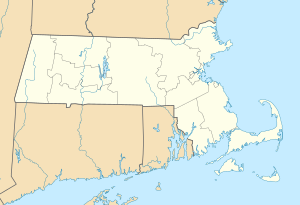
A lightvessel, or lightship, is a ship that acts as a lighthouse. They are used in waters that are too deep or otherwise unsuitable for lighthouse construction. Although some records exist of fire beacons being placed on ships in Roman times, the first modern lightship was located off the Nore sandbank at the mouth of the River Thames in London, England, by its inventor Robert Hamblin in 1734. Lightships have since been rendered obsolete by advancing lighthouse construction techniques, and by large automated navigation buoys.
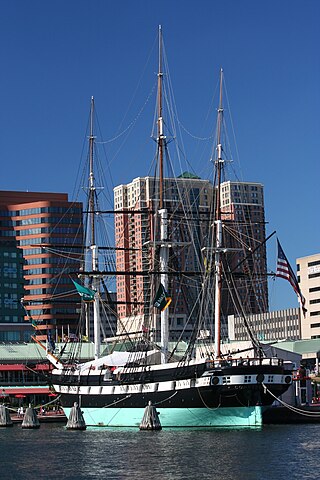
Historic Ships in Baltimore, created as a result of the merger of the USS Constellation Museum and the Baltimore Maritime Museum, is a maritime museum located in the Inner Harbor of Baltimore, Maryland in the United States.

United States lightship Chesapeake (LS-116/WAL-538/WLV-538) is a museum ship owned by the National Park Service and on a 25-year loan to Baltimore City, and is operated by Historic Ships in Baltimore Museum in Baltimore, Maryland. A National Historic Landmark, she is one of a small number of preserved lightships. Since 1820, several lightships have served at the Chesapeake lightship station and have been called Chesapeake. Lightships were initially lettered in the early 1800s, but then numbered as they were often moved from one light station to another. The name painted on the side of lightships was the short name of the Light Station they were assigned to and was the daytime visual aspect of the many Aids to Navigation on board lightships. The United States Coast Guard assigned new hull numbers to all lightships still in service in April 1950. After that date, Light Ship 116 was then known by the new Coast Guard Hull number: WAL-538. In January 1965 the Coast Guard further modified all lightship hull designations from WAL to WLV, so Chesapeake became WLV-538.

The United States Lighthouse Service, also known as the Bureau of Lighthouses, was the agency of the United States Government and the general lighthouse authority for the United States from the time of its creation in 1910 as the successor of the United States Lighthouse Board until 1939 when it was merged into the United States Coast Guard. It was responsible for the upkeep and maintenance of all lighthouses and lightvessels in the United States.
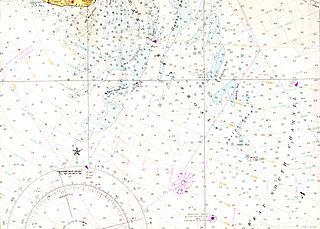
The station named Nantucket or Nantucket Shoals was served by a number of lightvessels that marked the hazardous Nantucket Shoals south of Nantucket Island. The vessels, given numbers as their "name," had the station name painted on their hulls when assigned to the station. Several ships have been assigned to the Nantucket Shoals lightship station and have been called Nantucket. It was common for a lightship to be reassigned and then have the new station name painted on the hull. The Nantucket station was a significant US lightship station for transatlantic voyages. Established in 1854, the station marked the limits of the dangerous Nantucket Shoals. She was the last lightship seen by vessels departing the United States, as well as the first beacon seen on approach. The position was 40 miles (64 km) southeast of Nantucket Island, the farthest lightship in North America, and experienced clockwise rotary tidal currents.

The United States lightship Huron (LV-103) is a lightvessel that was launched in 1920. She is now a museum ship moored in Pine Grove Park, Port Huron, St. Clair County, Michigan.

United States lightship Columbia (WLV-604) is a lightship located in Astoria, Oregon, United States of America. Columbia was formerly moored near the mouth of the Columbia River.

Light Vessel Number 83 (LV-83) Swiftsure is a lightship and museum ship owned by Northwest Seaport in Seattle, Washington. Launched in 1904 at Camden, New Jersey and in active service until 1960 after serving on all five of the American west coast's lightship stations, it is the oldest surviving lightship in the United States, the only one still fitted with its original steam engine, and the last lightship with wooden decks. LV-83 was designated a National Historic Landmark in 1989, and has been undergoing major restoration since 2008.
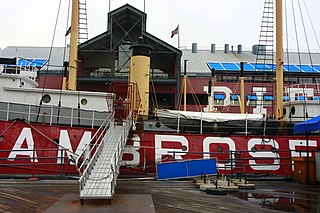
Lightship Ambrose was the name given to multiple lightships that served as the sentinel beacon marking Ambrose Channel, New York Harbor's main shipping channel.

United States Lightship 101, now known as Portsmouth as a museum ship, was first stationed at Cape Charles, Virginia. Today she is at the Portsmouth Naval Shipyard Museum in Portsmouth, Virginia. Portsmouth never had a lightship station; however, when the vessel was dry docked there as a museum, she took on the pseudonym Portsmouth. A National Historic Landmark, she is one of a small number of surviving lightships.

Wolf Trap Light is a caisson lighthouse in the Virginia portion of the Chesapeake Bay, about seven and a half miles northeast of New Point Comfort Light. It is listed on the National Register of Historic Places.
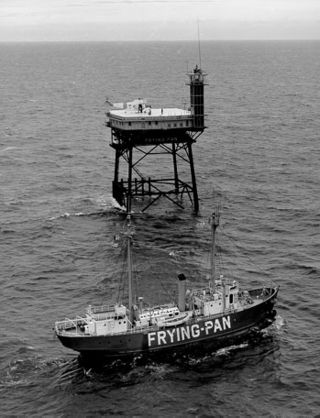
Frying Pan (LV-115) is a lightvessel moored at Pier 66a in the Chelsea neighborhood of Manhattan in New York City. It served at Frying Pan Shoals, off Cape Fear in North Carolina, for over 30 years.

United States lightship Relief (WLV-605) is a lightvessel now serving as a museum ship in Oakland, California. Built in 1950, she is one of a small number of surviving lightships, and one of an even smaller number built specifically for the United States Coast Guard. Along with her sister ship, the WLV-604 Columbia, she is a good example of the last generation of lightships built. She was declared a National Historic Landmark in 1989.

LV-117 was a lightvessel of the United States Lighthouse Service. Launched in 1931, she operated as the Nantucket lightship south of Nantucket Shoals. Moored south of Nantucket Island, Massachusetts, the lightship was at the western part of the transatlantic shipping lane and the first lightship encountered by westbound liners approaching New York Harbor. On May 15, 1934, one of these liners, RMS Olympic, rammed and sank LV-117, killing seven of her crew.

Lightship No. 114, later U.S. Coast Guard WAL 536, that served as lightship Fire Island (NY), Examination Vessel, Diamond Shoal (NC), 1st District relief vessel, Pollock Rip (MA) and Portland (ME). After decommissioning in 1971, in 1975 the lightship became a historic ship at the State Pier in New Bedford, Massachusetts. She received little maintenance, and eventually sank at her moorings in 2006 and was sold for scrap the next year.
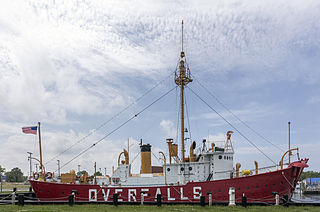
Lightship Overfalls (LV-118) was the last lightvessel constructed for the United States Lighthouse Service before the Service became part of the United States Coast Guard. She is currently preserved in Lewes, Delaware as a museum ship.
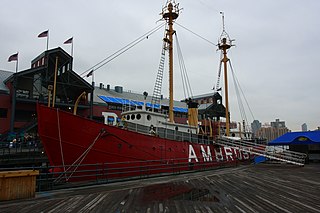
The United States Lightship LV-87/WAL-512 (Ambrose) is a riveted steel lightship built in 1907 and served at the Ambrose Channel lightship station from December 1, 1908, until 1932, and in other posts until her decommissioning in 1966. It is one of a small number of preserved American lightships, and now serves as a museum ship at the South Street Seaport Museum in southern Manhattan, New York City.
USC&GS Drift was a United States Coast Survey schooner built in 1876 specifically to anchor in offshore waters to undertake current measurements. She was transferred to the United States Lighthouse Board on May 20, 1893 to become the lightship Light Vessel # 97 or (LV-97) on the Bush Bluff station until retirement and sale in 1918 to become the W. J. Townsend which was scrapped in 1945.

The Nantucket Lightship or United States Lightship WLV-612 is a lightvessel commissioned in 1950 that became the last lightship decommissioned in United States Coast Guard service.

